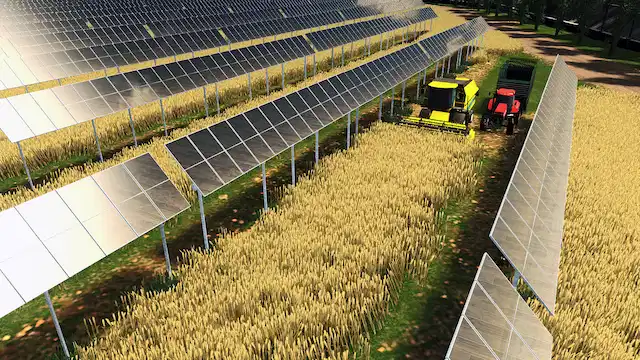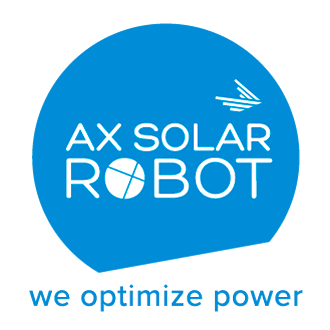Agrivoltaism:what is it ?
Solar fields are often opposed to agriculture because they replace land
The idea is to combine the two activities. Agrivoltaism is
all the technologies that make it possible to combine energy production
with agriculture or livestock farming. This is a relatively recent idea,
enables us to meet the growing need for green energy without hampering agricultural activity.
Agrivoltanism can have numerous benefits for different cultures and
different farms. Panels can be used to adapt crops
climate change, shading can help certain species to survive.
crops that are not sun-resistant or avoid excessive soil evaporation.

Solar palisades or agricultural photovoltaic shading systems protect
crops from the elements by reducing wind or rain, for example, which
can increase plantation yields as well as providing production
energy. Solar shading also improves the well-being of livestock by providing shade.
Why is agrivoltaics an opportunity?
According to the IPCC, agricultural production must increase by 50% between now and 2050 to allow for feeding the world’s growing population. It is therefore essential to
to preserve arable land, it is estimated that surplus production requires around 500 Mha of additional land.
At the same time, France is committed to achieving carbon neutrality by 2050 and the
The solar industry will have a major role to play in this transition. However
experts on large-scale ground-mounted solar power plants warn of the reduction in
availability of so-called “degraded” land (former mining land, site
These sites are home to most of today’s solar power plants.
However, the solar target calls for the deployment of around 40 GW by 2028, and the
The main barrier is the availability of land. Breeding and
occupy around 30 million hectares in France in 2024, that’s
therefore an attractive source for solar developers.
Solar energy must not supplant food production.
Project types
Dynamic shading :
Dynamic or tracker-mounted shading systems are solar panels installed above plantations to maximize or protect crops. They can be controlled
and therefore protect plantations from the sun and bad weather.
Tests have shown that dynamic shading systems can reduce
a plantation’s water consumption by 34%, thus drastically reducing irrigation requirements.
This system is mainly deployed for vineyards, market gardening and arboriculture,
In the case of vineyards, yields are not affected, but odor and taste can be improved on certain varieties, according to Vigne France.
Fixed shading systems :
Fixed shading systems are high-mounted installations that allow
coupling with all agricultural production requiring cultivation work,
mechanized or not. These types of farming facilities are relatively varied,
some are similar to photovoltaic greenhouse structures without walls
and can even be referred to as “open greenhouses” or “protection”.
photovoltaics”. They are mainly used to grow corn and wheat.
They are less flexible than tracker-mounted shading systems, and therefore cannot accommodate all crops.
Solar shading for livestock farming:
These are often islands dotted around pastures for cattle or bovines, or on poultry fields. They provide a varied environment for the animals, offering protection from bad weather or extreme heat, and thus improving livestock yields.
The combination of livestock farming underneath the solar panels results in greater fouling due to the dust and ammonia deposited on the solar panels, so the need for cleaning is greater.
Automatic feeding and milking systems can also be powered by solar shading systems, providing significant energy savings. It should be noted, however, that today, solar shade systems are not considered as valid shade points for organic farming labels.
Ground-mounted solar power plants:
Ground-mounted solar power plants are not compatible with agriculture, with the exception of certain specific applications such as vertical PV installations that can replace a planted hedge, for example. On the other hand, they are more conventional and well-developed than other applications, and combine perfectly with sheep farming.
The panels provide shelter for the animals, and limit the impact of climatic hazards on the land (drought, frost). An ideal installation to meet the challenges of climate change.
Livestock also have the advantage of maintaining the plant floor, thus limiting the need for maintenance to avoid shading, and making it easier to clean the plant.
Floating solar power and fish farming :
Floating solar power can be a good combination with fish farming. It helps limit the heat of the water by providing shade over the water, and the panels also offer defense against potential predators.
Agrivoltaism is therefore an opportunity for solar power to develop in symbiosis with agriculture, rather than in opposition between the two activities for the available land.
Agrivoltaic power plants are highly diverse, and are likely to become even more so in the years to come, so government and farmers need to work together to best combine agri-food production and electricity generation. These issues are crucial, and need to be directly aligned with energy objectives, farmers’ economic realities, as well as local conditions and climate change.
